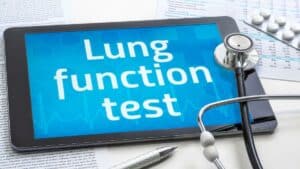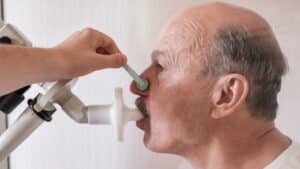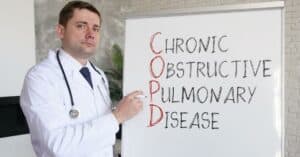People living with chronic obstructive pulmonary disease (COPD), pulmonary fibrosis, emphysema and other types of chronic lung diseases have had a spirometry test.
Typically, doctors use spirometry to help them better understand the severity of your chronic lung disease symptoms and how they affect your life.
Here we break down the key facts about a spirometry test and what your results mean.
What is a Spirometry Test?
Spirometry is a type of pulmonary function test (PFT). A spirometry test measures the amount of air you inhale, the amount of air you exhale and how quickly you exhale. In a spirometry test, your lungs are tested to see how well they are working.
There are several measurements gained from spirometry. Some of the important measurements determined from a spirometry test include forced vital capacity (FVC), forced expiratory volume (FEV), forced expiratory volume in one second (FEV1) and total lung capacity (TLC).
- Forced Vital Capacity (FVC) is the total amount of air you can exhale after taking the deepest breath possible.
- Forced Expiratory Volume (FEV) is the amount of air you can forcefully exhale during the first, second and third seconds of the FVC test.
- FEV1 or forced expiratory volume in one second is the amount of air you can forcefully exhale during the first second of the FVC test.
- Total Lung Capacity (TLC) is the total amount of air in the lungs after inhaling a deep breath.
What Do Normal, Predicted Values in Spirometry Mean?
If you’ve had a pulmonary function test, you’ve likely heard the term “normal, predicted values.” Doctors compare spirometry test results to normal, predicted values. Basically, normal, predicted values are gained during population-based research studies of people with normal lung function.
After you have your spirometry test, your doctor compares your test results to the normal, predicted values from people who are similar to you in age, height, weight, gender and ethnicity.
Generally speaking, normal results often have an FVC and a FEV1 above 80 percent predicted with a FEV1/FVC ratio that is greater than 70 percent.
While these predicted values may still seem confusing, we break down the spirometry test results even further below.
How Do Doctors Interpret Spirometry?
After your spirometry test, your doctor will go over your results and interpret them. There are several methods your doctor may choose to interpret your results.
For example, your doctor may start by looking at the forced vital capacity (FVC) to figure out if it’s in the normal range. Next, your doctor may look at the forced expiratory volume in one second (FEV1) to determine if it’s in the normal range.
If your doctor sees that the FVC or FEV1 (or both) are decreased, your doctor will look more closely into your test results. Now, your doctor will look at the percent predicted for FEV1/FVC. An obstructive lung disease, such as COPD, typically has a percent predicted of 69 percent or less.
Your doctor may recommend further testing.
What Do My Spirometry Test Results Mean?

Your spirometry test results can help your doctor diagnose COPD and other chronic lung diseases. It can also tell your doctor how much damage has occurred within your lungs.
At this point, your doctor may need more tests, or your doctor may have enough information to place your lung disease into stages or categories.
Often, doctors categorize COPD using two types of staging systems: the GOLD System and the BODE Index.
GOLD System
Developed by the Global Initiative for Chronic Obstructive Lung Disease, the GOLD System uses the forced expiratory volume in one second (FEV1) result from a pulmonary function test to categorize the severity of your COPD into stages or grades.
- Very Mild COPD or Stage 1: Mild COPD with a FEV1 about 80 percent or more of normal.
- Moderate COPD or Stage 2: Moderate COPD with a FEV1 between 50 and 80 percent of normal.
- Severe COPD or Stage 3: Severe emphysema with a FEV1 between 30 and 50 percent of normal.
- Very Severe COPD or Stage 4: Very severe or end-stage COPD with a lower FEV1 than Stage 3, or people with low blood oxygen levels and a Stage 3 FEV1.
BODE Index
The BODE Index is another way doctors place COPD into stages. The main difference between the BODE Index and the GOLD System is that the BODE Index accounts more for how COPD affects your life.
The BODE Index stands for Body Mass, Obstruction of Airflow, Dyspnea (difficulty breathing) and Exercise Capacity.
Often, doctors use a combination of both the BODE Index and the GOLD System to help them stage COPD and other chronic lung diseases. Your doctor will look at all your test results to develop the best COPD treatment plan for you.
Can I Improve My Spirometry Test Results?
Currently, there is no cure for COPD and other chronic lung diseases. While COPD and chronic lung diseases are progressive diseases and will worsen over time, there are treatment options available to help you manage your symptoms.
For some people, certain spirometry test results may improve once they begin a COPD treatment plan. However, this may not happen for everyone.
It’s important to continue to keep track of your spirometry test results though, so you and your doctor can help you maintain the best quality of life possible.
One of the most important steps anyone can take is to quit smoking.
In addition, your doctor may recommend changing your diet and exercise routines to better suit your needs. Many people with COPD have trouble getting enough of the nutrients they need form their food.
This makes it hard for them to maintain a healthy weight. To help you gain weight or maintain a healthy weight, your doctor may recommend you eat more lean protein like baked chicken, salmon, mackerel and various types of nuts.
Creating a healthy COPD diet can help with your overall health and could help improve your energy.
In addition, your doctor may prescribe certain types of medications and treatments, such as inhalers, corticosteroids, anti-inflammatories, oxygen therapy or pulmonary rehabilitation.
These types of COPD treatments may be used in combination with each other to help people manage more of their COPD symptoms.

Christine Kingsley, APRN is the Health and Wellness Director at the Lung Institute where she focuses on providing helpful online resources for people looking for information on various lung diseases, breathing exercises, and healthy lifestyle choices. She advocates for holistic care that involves working with your doctor to explore all options including traditional and alternative care while focusing on diet and exercise as proactive measures.









